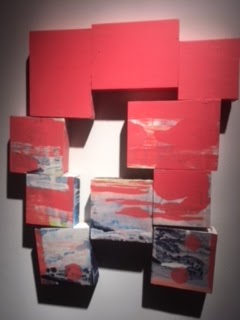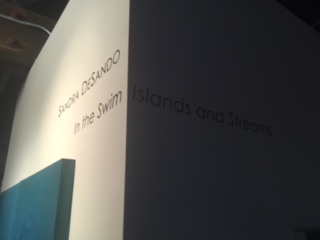That idea of being part of a whole runs through her work, branching out from the idea of being a part of the human whole to encompassing being part of the natural world also. As we spoke in her studio, she described some experiences she'd had that had caused her to recognize that she had experienced ecological grief upon seeing places in the natural world that she loved be overtaken and destroyed by people and construction. The article "Hope and Mourning in the Antropocene" by Neville Ellis enlightened her to what she was feeling and why, and the books "Last Child Into The Woods: Nature Deficit Disorder" by Richard Louv, "Symbiotic Planet" by Lynn Margulis and "What is Life" by Lynn Margulis and Dorion Sagan; "The Miracle of Trees" by Olavi Hulkart, and "The Hidden Life of Trees" by Peter Wohllenben, opened her mind and spirit to the desire and necessity inherent in all of us to connect and communicate with the natural world. Upon having an opportunity to go to Germany for a residency deep in the woods, and removed from civilization, she found herself sketching the world around her at first to fulfill the goals of the residency and what she had written in her proposal to do there, to draw or paint an image and then destroy it by overpainting to show what people are capable of doing to nature, and then she started to just simply be there - to sit and feel and communicate with nature in this place where the medieval structures and old growth forests had a true sense of peace and co-existence.
Returning from Germany she began a new series of work as she entered into a residency with the Eileen S. Kaminsky Family Foundation (ESKFF). Her work in the current group show at Novado Gallery highlights some of the work from that residency, and she is also part of another show in Jersey City at the Drawing Rooms' Art Project at Gallery 109 Columbus with larger works on paper that in their own way, though very different in structure and form, branch emotionally from that work. "In The Swim: Islands and Streams" at Novado Gallery showcases her works on panel board, and in a recent artist talk she spoke about how although she felt the importance of using panel board for those pieces, because of the eventually prohibitive cost and the inability to truly play with shape and form while using the pre-made panel boards she had been using, she started making her own. In reading more about her work, that kind of resiliency, practicality and continuing exploration seem to be themes that reoccur. In addition to numerous exhibitions, she has received prestigious foundation grants, has attended YADDO, has had fellowships and residencies and has worked in managerial and directorial roles with a variety of well known arts organizations in Jersey City and New York. Her art was part of the Smithsonian Museum's "Seeing Jazz: Artists and Writers on Jazz" and she was a member of the Heresies Collective, a women's group that published Heresies Magazine.
The day that I visited with her in her studio, some of the larger works on paper that are currently being shown at the Drawing Rooms were on the walls and on her table, with a few telltale signs of her panel board making workshop around them. The space overlooks a new park, and we spoke about how although what had been there before was not usable for exercise or play as the new park is, the park itself has no trees. One of her pieces at Novado Gallery highlights a neighbor's tree and another a stand of irises that had bloomed in profusion. The tree had been cut down and the irises might stop blooming, but in Sandra De Sando's beautiful and compassionate art they continue to be a part of us and will live forever.
Sandra De Sando
In Her Studio
Jersey City, New Jersey
And At Novado Gallery
For An Artists Talk
With Curator and Co-Owner Anne Novado
At The Opening At Novado Gallery
With Sunil Garg And Cheryl Gross
Blessings,
Jannie Susan







































































